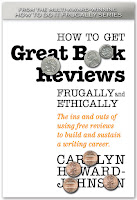Interweavings
Subtitle: Creative Nonfiction
Author: Carol Smallwood
Genre: Creative Nonfiction
Publisher: Shanti Arts Publishing, Brunswick,
Maine, 2017
ISBN 978-1-941830-46-8
Paperback, $16.95, 162 pages.
Reviewed by Patti Gibbons originally for Amazon
Accomplished author, poet, and
editor Carol Smallwood’s latest offering, Interweavings:
Creative Shanti Arts Publishing, 2017, is a collection of essays that offers readers a chance to view
select moments of Smallwood’s life where she pauses, as a woman and as a writer,
to reflect, analyze, and contemplate the interconnectedness of her earlier
self, life’s universal moments, and the outlook that comes with the passage of
time. Smallwood’s perspective brings strength ingrained in her as a member of
her generation’s feminist movement, a theme that supports the overarching tone
of the collection of essays.
Smallwood’s assembly of over forty
essays are organized into seven thematic chapters, and work on the individual
essay level, as groups of essays, and finally as a whole collection. Looking at
the mundane, such as visits to the post office or to the library, Smallwood
works in an accessible realm, one which readers of all backgrounds can relate
to, but her voice filters her experiences through her vantage point, namely as
a woman born in a pivotal generation, and through it rings a perspective that
prompts readers to go beyond an interpretation of her stories as descriptive
pieces, to a body of work that provides a faceted look at the small moments of
life that communicates deeper meanings and speaks to experiences Smallwood
narrates from her reflections across her lifetime. Smallwood shares her private
thoughts in clear and uncensored terms, not for shock value, but as a
reflective simplicity that has come clearer into view as she benefits from the
long view of maturity.
Interweavings:
Creative Nonfiction is a peek into a writer’s sketchbook, a collection of
ponderings and meditations when the author encounters silently powerful moments
in her everyday life, and rubs and massages them to tease out the emotional
underpinnings and delineates how each speaks not only to the conversation at
hand, but to deeper dialogues when examined in light of a lifetime of living
and experience. The perspective presented in the individual essays is perhaps clarified by the writing
process, and Smallwood, as an author skilled in many genres, is able to share
feelings, sentiments, and wisdom with an apparent simplicity and economy of
words, due in large part to her mastery as a writer. Smallwood’s Interweavings: Creative Nonfiction shows
universal expressions of feeling.
Readers of all backgrounds could
easily connect with the themes, and readers seeking to examine American life
and the life of twentieth century women, in particular, would delight in the
insight Smallwood provides, and the honest reflections she shares. Smallwood’s
essays leak with quiet sentiment and encourage readers to approach her prose intuitively.
Honest and uncoated, Smallwood evenhandedly leads readers through a series of
richly described vignettes that are relatable and prompt readers to interject
themselves into the circumstances she writes about, to experience situations first-handedly
themselves, as well as on behalf of the author.
As Dr. William Brevda, Professor of
English at Central Michigan University, aptly points out in the foreword, “What
Smallwood has written is literature. It has staying power.” Through her
descriptive yet careful voice, Smallwood candidly captures how she experiences
daily life through the medium of language in a profound manner that reaches the
level of lasting art.
MORE ABOUT THE REVIEWER
Patti Gibbons works at the University of Chicago Library in the Special Collections Research Center.
MORE ABOUT THIS BLOG

The New Book Review is blogged by Carolyn Howard-Johnson, author of the multi award-winning
HowToDoItFrugally series of books for writers. Of particular interest to readers of this blog is her most recent
How to Get Great Book Reviews Frugally and Ethically (
http://bit.ly/GreatBkReviews ). This blog is a free service offered to those who want to encourage the reading of books they love. That includes authors who want to share their favorite reviews, reviewers who'd like to see their reviews get more exposure, and readers who want to shout out praise of books they've read. Please see submission guidelines on the left of this page. Reviews and essays are indexed by genre, reviewer names, and review sites. Writers will find the search engine handy for gleaning the names of small publishers. Find other writer-related blogs at
Sharing with Writers and
The Frugal, Smart and Tuned-In Editor.




![The Empath's Survival Guide: Life Strategies for Sensitive People by [Orloff, Judith]](https://images-na.ssl-images-amazon.com/images/I/51ZI6-gvJ-L._SY346_.jpg)
